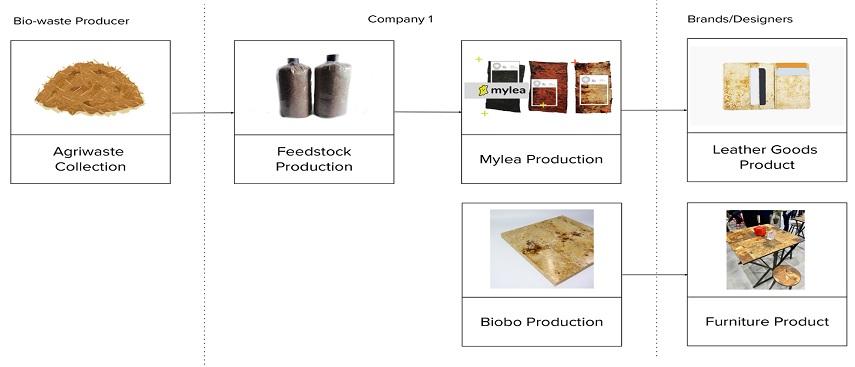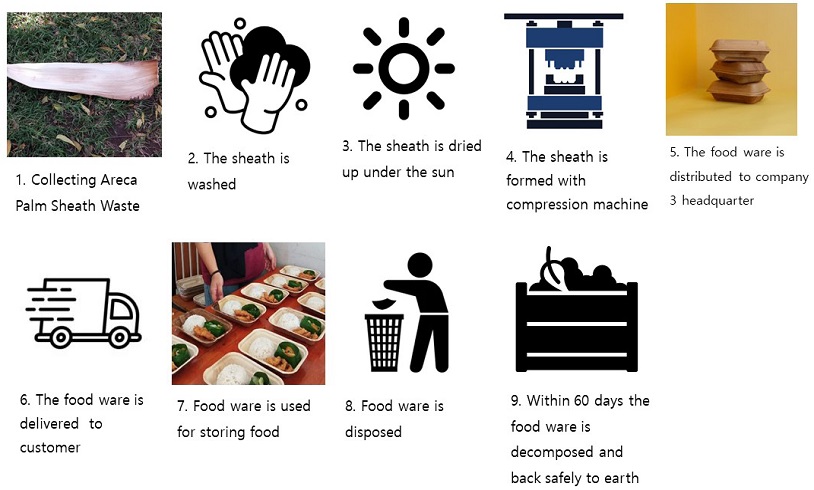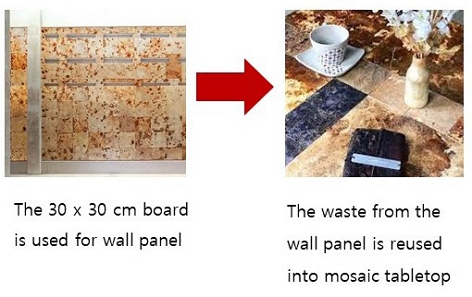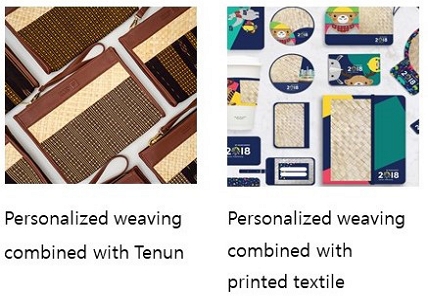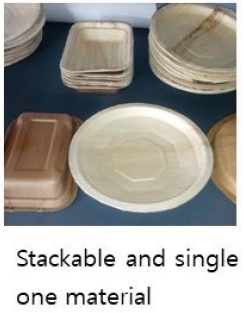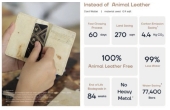
Eco Design Strategies at Indonesian Creative Social Enterprises
Abstract
Background This research looks at how ecodesign can support Indonesian creative social enterprises to achieve sustainability by incorporating ecodesign approaches. Previous research has stated that implementing ecodesign leads to better product for market, environment, and superior business performance.
Methods This is a qualitative exploratory study using a multiple case study approach. The data collection methods include in-depth interviews, a literature review, and data documentation. The findings of this exploratory study serve as the foundation for cross-case analysis. The study is based on ecodesign literature and three case studies of creative social enterprises (CSEs). The study is divided into two stages, the first of which is a literature review to develop the research instrument, followed by expert validation. The second stage consists of gathering primary data on three creative social enterprises, followed by cross-case analysis, and finally validation by sustainable design lecturers as experts. The research subjects are five creative social enterprise entrepreneurs, two managers, and four experts.
Results We formulated eight ecodesign strategies. Two strategies are good for the planning phase: Design for durability and Design for dematerialization. Six strategies are fit for the development phase: Design for attachment and trust, Design for standardization and compatibility, Design for maintenance and repair, Design for adaptability and upgradability, Design for ease of disassembly and reassembly, and Design for recycling. All three CSEs have not applied the design for maintenance and repair strategy. The study also manages to formulate 27 research and development (R&D) activities that need to be conducted to perform the strategy. According to the findings of the study, CSEs that develop their own sustainable materials, engage in more ecodesign R&D activities than CSEs that use readymade natural materials.
Conclusions The empirical results show that the ecodesign strategy is very company specific, and regardless of differences, all creative social enterprises demonstrate the ability to develop ecodesigns that improve environmental performance.
Keywords:
Eco Design, Creative Social Enterprise, Sustainability1. Introduction
The growing concern about environmental damage has increased the need for businesses to pay closer attention to the negative impact of their operations, especially in product development (Guo, 2021). According to Wimmer et al. (2010) environmental issues should not be viewed solely as a problem, but rather as a business opportunity that can provide companies with a competitive advantage.
One effective approach to limit the negative environmental impact in product development is through eco-design. Eco-design has become so crucial because 80% of the ecological impacts of a product are locked in at the design phase (Acaroglu, 2020). It can reduce the negative environmental impact by prioritizing environmental variables alongside efficiency, aesthetic qualities, cost, ergonomics, and functionality (Platcheck, Schaeffer, Kindlein, & Cândido, 2008).
Furthermore, eco-design is operated by designers. They play an important role in eco-design because they are placed at the beginning of the product development process, when the design brief is most fluid and the most crucial decisions regarding cost, appearance, material selection, innovation, performance, environmental impact, and quality perceptions (longevity, strength, reparability) are made (Lofthouse, 2004). By implementing eco-design at the very beginning of a product's development, it can provide greater potential to increase environmental performance (Behrisch et al., 2011). Impact on the environment should be evaluated throughout the entire product lifecycle, from raw materials extraction to product disposal. Eco-design is considered as effective because it combines creative thinking, innovation and environmental stewardship (Plouffe et al., 2011).
The primary goal of eco design is to anticipate and minimize the negative effects of manufacturing, using, and disposing of products on the environment, while also maintaining a product's quality level in accordance with its intended use (Luttropp & Lagerstedt, 2006). This paper adopts the definition of eco-design by ISO 14006 (2020 p. 20), “the integration of environmental aspects in product design and development with the aim of reducing adverse environmental impacts throughout a product’s lifecycle”.
Knowing that eco-design can bring businesses toward sustainable development, in recent years, more businesses prioritize the implementation of eco-design to achieve product sustainability (Bugali & Gulari, 2016), and one of them is Creative social enterprise. It is defined as “a type of social enterprise that generates market demand for creative goods and services, through intellectual property, ideas, and imagination while also contributing to a global dynamic shift toward cultural sustainability, social justice, and economic development” (Trapp, 2015 p. 22). There are 75,240 Creative Social Enterprises (CSEs) in Indonesia and dominated by young entrepreneurs (British Council, 2020). There are many young people in Indonesia who want to work in an area where they can create a difference rather just earning a salary.
Most creative social enterprises in Indonesia are SMEs in early-stage phase (British Council, 2018). According to World Wildlife Fund (WWF) of Indonesia and Nielsen survey results from 2017, up to 63% of Indonesian consumers were willing to pay a higher price for eco-friendly products. This reveals a significant growth in consumer awareness of the consumption of sustainable products, and this shows that the Indonesian market is ready to absorb sustainably produced products. This opens business opportunities for creative social enterprises, their numbers are continuing to grow in coming years.
The sustainable market is expanding, and sustainable consumers want products that are not only socially and environmentally responsible, but are also innovative (Bosma et al., 2015). The desire for innovative products are also supported by Suhaily et al. (2020) who stated that green product innovation and green perceived quality have a significant and positive effect on green product purchase intention among Indonesian people. Knowing that innovation is important for consumers, 99% of Indonesian CSEs emphasized the importance of innovation and creativity in their business operations. However, Research & Development (R&D) is not a business priority for them. Only one-third of Indonesia's CSEs conduct R&D (British Council, 2020).
On the other hand, Eco-design is an approach that require intense R&D, because it requires designers to think about the whole product life cycle, it is not just about the present but also the future (Kant & Kanda, 2019). Eco design can enhance R&D activities in a company, because to create new product with minimal environmental impact it requires intense R&D activities (Chebaeva et al., 2021; Gumulya & Andriato, 2020).
Despite of the majority of Indonesia CSEs have R&D problem, there are some CSEs in Indonesia who are innovative because of their R&D activities. They have received several national and international innovation awards for their sustainable products, and they have demonstrated strong eco-design activities (DBS Foundaition, 2018). This paper discusses the eco-design activities conducted by the innovative CSEs. We argue that eco-design can increase the low R&D activity of creative social enterprises, and through eco-design approach, CSEs can provide sustainable consumer with innovative, socially, and environmentally responsible products.
1. 1. Problem Definition
Although eco-design has been established as a strategy that can assist businesses to achieve sustainable development, current literature reviews have presented only a limited account of what R&D actions that can be taken to achieve eco-design. Most eco-design researches focus on eco-design conceptualization, benefits, methodology, and tools (Aoe, 2007; Boks, 2006; Chebaeva et al., 2021; Cluzel et al., 2014; Karlsson & Luttropp, 2006; Kengpol & Boonkanit, 2011; Le Pochat et al., 2007; Lofthouse, 2004; Maccioni & Borgianni, 2019; Platcheck, Schaeffer, Kindlein, & Cãndido, 2008).
As a result, we pose two research questions, as follow:
- 1. What eco-design strategies do innovative creative social enterprises employ at each stage of product development?
- 2. What kind of design activities that can be taken to achieve the creation of eco-friendly products?
The purpose of the study is to present eco-design strategies that are appropriate for creative social enterprises, as well as a set of design activities that can be taken to develop products with minimal environmental impact by implementing various eco-design strategies at each product development phase.
1. 2. Literature Review
Eco-design strategy are set of approaches on how to design for value by prioritizing environmental variables together with efficiency, aesthetic qualities, cost, ergonomics, and functionality (Platcheck, Schaeffer, Kindlein, & Cândido, 2008).
Previous researchers have identified eight eco-design strategies that can be selected depending on the business model of the company (Behrisch et al., 2011; Han. Brezet et al., 1997; Gumulya & Andriato, 2020; Quella, 2013; Wu et al., 2021):
- 1. Design for attachment and trust: a design that encourages consumers to develop a strong emotional connection with the product and that connection helps consumers extend the product's life. As they are less likely to discard products with a strong emotional connection.
- 2. Design for durability: a design that is robust, built-in good quality to reduce the likelihood of failure. The designer's job is to match the product's economic and stylistic lifetime. For example, it makes no sense for a temporary disposable product to be extremely durable.
- 3. Design for standardisation and compatibility: a design with product components that are interchangeable with readily available components, so it simplifies repair and extends the life of the product. This fosters a culture of reuse and helps to reduce overall consumption, as a single product can be repaired and repurposed. For instance, charging the phone and the tablet with the same charging device rather than two separate chargers.
- 4. Design for maintenance and repair: a design that can be extended its life cycle by adding product maintenance. Repairs can be laborious, especially in highly developed countries with higher labor taxes. Sometimes, repairs can be more expensive than just buying a new one.
- 5. Design for adaptability and upgradability: a design that enables future modification. As product features evolve over time, they must be updated. For instance, a highchair for children that converts to a dining room chair as the child grows. While computer software updates can assist products in adapting to technological change, there are times when the rate of technological development exceed the rate of the upgrade.
- 6. Design for ease of disassembly and reassembly: a design that incorporates features that facilitate maintenance and repair. Products are designed in modular fashion to allow for easy disassembly and reassembly. Not only do these actions increase the repairability and reusability of products, but they also increase their recyclability.
- 7. Design for recycling. A design focuses on the application of specific design techniques to maximize material recovery during the recycling process. The technique entails avoiding the use of mixed materials in order to facilitate recycling.
- 8. Design for dematerialization: a design with less packaging and minimal material types. Occasionally, a product may be replaced by a service that consumes fewer resources. One example is to transition to streaming services rather than purchasing CD, DVD, or Blu-ray disks.
There are many benefits for company to adopt eco-design strategies. Previous research's arguments for the benefits of eco-design are presented in table 1.
2. Method
Considering that Eco-design practices in Creative Social Enterprises is under explored domain in developing countries. We implemented qualitative exploratory research with multiple case study approach.
The exploratory case study is the best method for investigating distinct phenomena that are characterized by a lack of comprehensive preliminary research (Mills et al., 2012). The case in this study is creative social enterprises that use eco-design strategies to create their sustainable product designs.
In choosing cases, we applied theoretical sampling in which cases may be chosen because their ability to answer the research questions by providing examples (Eisenhardt, 1989).
Based on the literature review of eco-design strategies (Behrisch et al., 2011; Han. Brezet et al., 1997; Gumulya & Andriato, 2020; Quella, 2013; Wu et al., 2021). We develop our case selection criteria. Table 3 goes into detail about each case.
- 1. CSEs have received numerous local and international sustainable innovation recognition awards.
- 2. CSEs are under the creative industry category.
- 3. CSEs use sustainable materials for their products.
- 4. CSEs minimize negative environmental impact shown by their impact report.
The study conducted in-depth interviews with 5 entrepreneurs, 2 CSE managers, and 4 experts. In total there are 11 respondents. The respondents are selected based on the following criteria:
- 1. The interviewee should be a senior manager, such as the CEO, the R&D manager, or the general manager that oversees the product development process.
- 2. The interviewee should have at least 5 years of working experience, indicating that they have extensive knowledge and experience in eco-design.
The 11 respondents are adequate to represent this study because the data has reached a point of saturation, at which point the researcher can conclude that there is no need for additional interviews (Saunders & Lewis, 2015). According to Saunders & Lewis (2015), the sample size for in-depth interviews is 5–25 respondents. Furthermore, for all types of qualitative research, at least 5 interviews were required to meet the sample size requirement (Brinkmann, 2013).
The research project began in May and concluded in July 2021. The questions were developed using data from the literature review, the research objective, and the research questions. The data is validated using data triangulation, which involves obtaining information from a variety of sources, including employees, entrepreneurs, and experts.
We contacted the interviewees via social media direct message and scheduled an interview session. Figure 1 depicts the detailed procedure of the study.
The interview guide cantered on key themes eco-design strategy and their activities and divided into three sections:
General Questions:
- • Name of respondent:
- • Positions:
- • How many years have you worked in the creative social enterprises?
- • What is your involvement in the design process?
- • Tell me the background of your company, when and how is it founded?
Formation phase:
- • Can you describe to me your production process from input to output?
- • What is the design strategy for your company?
Operational phase
We explain eco-design definition, eco-design strategy and the activities to the interviewees.
The definition of eco-design discussed here is by ISO 14006 (2020 p. 20), “the integration of environmental aspects in product design and development with the aim of reducing adverse environmental impacts throughout a product’s lifecycle”.
- • Tell me how is your eco-design process?
- • We explain our research instrument and ask questions on each eco-design activities.
We finish the first interview, then we analyse the data that has already been gathered. A few days later, the second interview take place. The table has been filled with data from the first interview by the researchers (see table 3). Then we ask interviewees for their opinions and elaborate further by asking supporting data to back up their claims.
Throughout the interview sessions, the interviewees are very open about the research because they recognize the importance of eco-design for Indonesia's future sustainable development (see figure 2). All interviews were carried out using a video-conferencing platform lasted between 1.5 – 2 hours. To facilitate transcription, all videos were uploaded to YouTube.
The data is examined with cross-case analysis, a technique that examines themes, similarities, and differences between cases (Miles et al., 2014). The goal of cross-case analysis is to improve validity, generalizability, and theoretical elaboration (Mills et al., 2012).
2. 1. Reliability and Validity
The reliability and validity of this research is through expert validation and cross case analysis. It is necessary to do interviews with the experts in this field to ensure that research result is valid (Wahyuni, 2016). The first two experts in the studies are people with extensive working experience advocating sustainable development in creative social enterprises and the other two experts are sustainable design lecturers from two prominent private universities in Indonesia.
The interview with experts were divided into two stages. The first interviews were with two experts, the aim was to validate the eight formulated eight eco-design strategies along with their activities. The second interview with experts was to confirm cross case analysis of the case study. The four experts’ short profile is presented in table 3 and depicted in Figure 3.
3. Result
Stage 1
Expert Validation 1
As mentioned in research method, the research process is divided into two stages. First, we validate our eco-design strategies and their activities which we considered as our research instrument (see table 1) with two experts from Small & Medium Enterprise and Cooperatives of Indonesia (SMESCO) (see figure 3). The experts confirm our research instrument can be used to observe eco-design strategies in different CSEs and provide some recommendations on case selection:
- 1. Company’s size influence eco-design strategies. Smaller companies tend to have more flexibility rather than big companies. The expert advises us to choose CSEs that are similar in size.
- 2. Some businesses in Indonesia create false impressions or provide misleading information about how their products are better for the environment, a practice known as greenwashing. Experts advise us to select only CSEs that have publicly disclosed their sustainable impact. We have mentioned several candidates of cases and together with the experts we formulate the case selection criteria described in table 2. Collectively, we select the three cases.
- 3. Aside from case selection recommendations, experts also elaborate further and assert that clear and focused strategies, as well as the right system and culture, are required to build eco-design. Experts emphasize that building the right system and culture for all employees—from top executives to assembly line workers—to personally participate in daily corporate sustainability efforts is critical to developing a vibrant and sustainable company.
- 4. Experts believe that what distinguishes CSEs from other traditional companies are their ability to balance profit and impact, as well as the fact that they are not only selling products but also advocating a vision for a sustainable lifestyle.
Stage 2
After gaining validation and insights from the experts. The research goes on collecting primary data through interview and secondary data from the company.
Company 1
A creative social enterprise established in 2015 creating environmentally friendly composite materials using agricultural waste and mycelium mushroom fermentation techniques. It was founded by five high school friends who decided to create business together. It now has a total of +30 employees. Company’s 1 vision is to provide high-performance and environmentally friendly materials to the global market via biotechnology and community empowerment. Company 1 is based in Pakuhaji Village, Bandung, Indonesia. Agricultural waste is obtained from agriculture near their factory. It has two product category biomaterials board (named as “biobo”) and vegetable leather (named as “mylea”). Figure 4 is company 1 zero waste production flowchart. The company has hold three patents for producing the biomaterials.
Looking into the details of company 1 zero waste production flow are described on figure 5. To implement the best eco-design strategy, a thorough understanding of the entire manufacturing process is required.
An in-depth interview is conducted to learn more about how the CSE implements eco-design strategies.
1. Q: What is your company's design strategy?
“Our design strategy is to create a good sustainable product is through gaining a deep understanding of the material through hands-on explorations and prototyping with the materials.”
2. Q: Can you describe to me, how is your eco-design process?
“We usually begin with the material, and once we understand its strengths and limitations, we consider which product is best suited to the material. For the time being, we are concentrating on the creative industry, a market with low production but high added value. After determining the target market, we co-create with local and international designers to exchange ideas and product knowledge. Together, we create prototypes, which allows us to accelerate our innovation process. Now we have a variety of product categories made from our material, such as jackets, bags, shoes, slippers, book covers, wallets, watches, and eyeglasses."
Company 2
A creative social enterprise manufactures and distributes wicker crafts with the goal of empowering women, promoting culture, and enhancing rural Indonesian livelihoods. It was founded by three high school friends who decided to create a business together. Company 2 social mission is to improve maternal health and the economy in rural Indonesia. To achieve the mission, it sells the weaving craft to businesses clients. The weaving crafts are made from lontar leaves, which are abundant in East Nusa Tenggara. In 2014, It began its first project with eight mothers in Duntana Village, East Flores County. East Nusa Tenggara is one of Indonesia's poorest provinces, with one of the world's highest maternal and new-born mortality rates. The founders of company 2 saw an opportunity to address maternal and new-born health issues while also providing alternative employment through existing woven traditions. Company 2 now has a total of +30 employees that are in Jakarta and East Nusa Tenggara and have empowered + 1400 weavers in rural area of Indonesia.
Looking at the details of Company 2's production flow, which is described on figure 6, we can see that the company has two product categories. The first is the style product category for corporate gifts that combines weaving with other materials, and the second product category is home accessories that are mostly made of natural materials. As mentioned before company 2 serves businesses clients, the style product category is for corporate clients and the home accessories is for hotels clients. The initial stages are the same, but when it comes to the final stage, the process divides into two streams. The weaving in the style category is combined with other materials, whereas the weaving in the home accessories category can be combined with other natural materials or made entirely of lontar leaves. From a sustainability standpoint, stitching the weaving with other materials complicates the disassembly process, which is bad for the environment.
An in-depth interview is conducted to learn more about how the CSE implements eco-design strategies.
1. Q: What is your company's design strategy?
“Our design strategy is to provide marketable wicker products to people in Indonesia and other parts of the world by utilizing the most authentic craftsmanship from artistically gifted women”.
2. Q: Can you describe to me, how is your eco-design process?
"We usually start by looking at what is on trend through social media. We want our product to be saleable and suitable for market needs. Because, through bulk order, our weavers can get a consistent income. After analyzing the trend, our R&D team creates a few designs, and our sales and marketing teams select the best three. We create several samples and conduct market testing to gather feedback, and we refine the sample based on the feedback. After that, we deliver the sample to our weaver in NTT. “
Company 3
A creative social enterprise develops food packaging containers from areca palm leaves to replace single-use plastic packaging. It was founded in 2018 by four young people. Containers made of areca palm leaves can decompose naturally in the soil within 60 days. This product can withstand temperatures of up to 200 degrees Celsius, is microwave safe, and is waterproof. It has a total of 27 employees. The company is currently in collaboration with 90 farmers from local cooperatives in Mendis Village, Banyuasin, South Sumatra, Indonesia. This location was chosen because of the abundance of areca palm leaf material are in Jambi and Sumatra. The farmer provides raw materials and overseas production. Through a series of trainings Company 3 empowers farmers who previously could not make environmentally friendly food packaging to eventually be able to do so.
The manufacturing concept is a micro-sharing factory in which company 2 establishes a production site in collaboration with local village cooperatives. Cooperatives provide production area for production and Company 2 provides machinery that has been adapted to the present rural infrastructure.
On figure 7 Company 3's production flow is described. We can see that company 3 has thought about the entire product lifecycle, from collection to cleaning, forming, and disposal back to the earth. The company repurposes areca sheaths, which are usually discarded, burned, and converts them into an alternative material for disposable packaging.
An in-depth interview is conducted to gain a better understanding of how the CSE implements eco-design strategies.
1. Q: What is your company's design strategy?
“Our design strategy is to create sustainable food packaging out of local waste by empowering local people who live nearby with our technology and know-how. Mendis village is just our first community, we are planning to expand our business model to other communities with their local waste, with our micro-manufacturing platform, every community can make a business out of their agricultural waste”.
2. Q: Can you describe to me, how is your eco-design process?
“From our research we conclude that we wanted to make food ware. Food ware made from areca palm sheath is not a new concept. This type of product is already manufactured in India. So, at first, we went to India to learn their process. We discovered that they only made plates, not food packaging, and that their machinery was very massive and required a high voltage to operate. We knew right away that we had to build our own machine. Back in Indonesia, we began by modifying the existing machine to be smaller and lower in voltage because we knew that in rural areas of Indonesia, there is still no electricity, and if there is, the supply isn't always stable, and power can go out for days. Following that, we began experimenting with mouldings. Once the machine and the moulding were finished, we went to the location where there is an abundance of areca leave sheath and collaborated with the local community through local cooperatives. We found several farmers who share our vision of reducing plastic waste and are willing to share their communal space for a production site. We bring machines and know-how from material collection, cleaning, forming, and distribution to the community. We also teach them how to properly dispose the sheath waste by composting them. So, for us our design approach is holistic we need consider all aspect of product life cycle from material extraction to disposal. We design based on the material characteristic and production technology available.”
The research goes on by analyzing the eco-design activities from each strategy to gain a deeper understanding of the eco-design strategies implemented by three companies. We analyze the data from the first interview and fill the cross-case analysis table 4. Then, in the second interview, we ask interviewees for their opinions and further elaborate by asking for supporting data to back up their claims.
Experts Validation 2
To ensure the reliability and the validity of our cross-case analysis we interview 2 experts who have experience teaching sustainable design at product design program for two prominent private universities in Indonesia.
The interviews produce several insights:
- 1. Experts asserts the first fundamental principle of sustainable product design is that an object's function should determine its design and materials. Experts agree that eco-design should start from material considerations.
- 2. Experts validate the eco-design activities conducted by the three CSEs. The results have certain degree of validity and provide certain structure to eco-design activiites.
- 3. Experts encourage us to research further how eco-design strategies are perceived from customer’s point of view.
- 4. Experts advise us to see how the eco-design strategy fits unto different product development stages, because each strategy can only be implemented in certain stages.
Cases Comparison
From the table 4 we can conclude that each companies have different eco design strategies. Company 1 and 3 have more eco design strategies than company 2, because both are creating their own material, while company 2 developing resources and skill that community already have. Looking into detail company 1 applies the design for durability, design for standardisation and compatibility, and design for dematerialization. The standardization design can be seen in that the material is moulded into 30 x 30 cm modules, which are used for wall panels and charging pad, the leftovers are used to make tabletops (figure 9). Company 1 and 3 uses design for dematerialization strategies because most of their products are made from 1 single material.
Company 2 applies the design for attachment eco design strategies by making personalized item that can be personalized to customer’s need and personality (see figure 10). The strategy is mostly applied in style category for corporate gift items. Customers can inquire about personalizing the products. By personalizing it creates more meaning and sense of attachment with the products.
From figure 11, Company 3 employs eco design strategies such as design for standardisation and compatibility, as well as design for dematerialization, by making modular plates and food ware that are standardised, stackable for space savings, and made from a single material product.
In terms of eco design activities, both company 1 and 3 apply the modular principle and simplifies the structural shapes of products to reduce production waste. By making standardisation the raw materials usage can be reduced. They also design with homogeneous material and less material combination. Meanwhile, company 2 use personalisation to create attachment give sense of enjoyment and memory.
Furthermore, based on experts recommendation, the study suggests that some eco design strategies can be implemented during the product planning phase, while others may be effective during the development phase (see table 5). Designing for durability with activities such as defining a long-lasting design style and careful material selection is appropriate for the planning phase. Design for dematerialization is another strategy that can be used during the planning phase. This entails planning a design with a lower energy content, designing with homogeneous materials, and designing with fewer material combinations. This finding support Behrisch et al. (2011) who stated in the product planning phase, low impact material selection is essential.
Strategies that may work for development phase is design for standardization and compatibility, design for adaptability and upgradability, design for maintenance and repair, design for ease of disassembly and reassembly, design for recycling as the activities can be used to develop the design. As described by Bugali & Gulari (2016) that developing product on component, structure and system level is key for eco design.
The findings also highlight the CSEs' lack of an eco-design strategy for maintenance and repair. Although they use biodegradable natural materials, there are other supporting materials that do not degrade easily and can be maintained to extend the product's lifetime. Furthermore, the study discovered that three CSEs did not consider product design for shared use. All CSEs sell the eco-designs as commodities, but the trend is shifting toward more products being sold as services.
4. Discussion
The findings highlight that each company has its own eco design strategies are consistent with the findings of Behrisch et al. (2011) who discovered that eco design practice is company specific, and that regardless of differences, all sustainable companies demonstrate the ability to develop completely new concepts that improve environmental performance, proven by their achievement getting different awards.
Although eco-design practices vary by company, the research suggests that during the planning phase of eco-design process, designers should think carefully about material selection, use one material rather than two, and employ a timeless design style that is subtle, adaptable, and yet looks sophisticated using sustainable materials. From the study, we suggest designers should select materials with low energy content and natural materials that are strong enough on their own and do not require any additional materials to perform the function. Furthermore, it is suggested that an object's design and materials should be determined by its function. This finding is supported by Geiser (2001), who claims that the best time to avoid environmental damage is when materials are designed and selected based on product usage. Ahn & Lee (2018) also asserts that material selection is key because it is the primary factor influencing the product life cycle circulation.
The research recommends that designers should consider the modularization principle during the development stage of the eco-design process to create standardisation that improves design adaptability and upgradability. The modular design principle also improves disassembly and reassembly, making recycling easier. The modularization principle as eco-design activities is consistent with the research of Yang et al. (2011) who states that modular design can help designers improve maintainability, reusability, and recycleability.
Based on the cross-case analysis, we especially recommend that Company 2 should begin to think about the design for maintenance eco-design strategy, which will help to extend the design for attachment strategy, a good eco-design should be easily repairable and maintainable. The study suggests that each CSE should implement eco-design strategies that complement one another.
In addition to the lack of design for maintenance and repair. The study recommends that CSEs should start shift their business paradigm from products to service mindset. Sharing economy is expanding and is thought to encourage sustainable practices (Ritter & Schanz, 2019). The study argues that eco-design can be scaled up through different sharing economy business models, such as subscription-based models, which can increase product lifetime and provide people more access to eco-design.
5. Conclusion
The purpose of this paper is to provide present eco-design strategies used by creative social enterprises. First, the study was able to shed light on how creative entrepreneurs use one or more eco-design strategies to create sustainable products. Second, the paper adds to current understanding by outlining key activities for implementing each eco-design strategy. Third, the study determines which strategies that may be effective during the planning and development phases. The key activities for each eco-design strategy presented in this paper are a good place to start when defining eco-design design activities.
Furthermore, the study discovers that the three CSEs use the following strategies: design for durability, design for standardisation and compatibility, design for dematerialization, and design for attachment. The three CSEs have not considered the eco-design strategy design for maintenance and repair and nor have they implemented product design for shared use. In addition, the study also suggests two important eco-design activities: material selection and modular design. When the three cases are compared, CSEs that create their own sustainable materials engage in more eco-design R&D activities than CSEs that use readymade natural materials. CSE can improve their environmental performance by implementing and expanding eco-design strategies and activities on a consistent basis.
In addition, we also highlight the importance of designers on eco-design process. Designers shape a product's impact over its lifetime to a large extent, the eco design strategies and activities could be valuable in guiding product designers of creative social enterprises on how to conceptualize a product with sustainability in mind.
Finally, the study recommends that the three CSEs should constantly expand their eco-design strategy to improve environmental performance, because some strategies work better together.
6. Limitation & Further Studies
There are certain limitations in the study results. First, the study hasn’t touched any discussion about how eco design may related with cost reduction, but the study manages to discuss about energy consumption reduction in design dematerialization activities.
Furthermore, the study hasn’t research how technological and managerial support may play role in eco design strategy. Further study can highlight financial, technological, and managerial aspect may play role in achieving eco design strategy.
Another constraint worth mentioning is that the study did not address the customer's point of view; therefore, future research should address how eco-design strategies are perceived by customers. Given the possibility of a mismatch between CSE intentions and customer responses in eco-design.
According to the study, CSEs have not considered sharing the use of their products. This piqued the interest of new research in how eco-design strategies can be adapted to the sharing economy paradigm and principles. There hasn't been much discussion of this topic in previous studies. Hence, we propose that the evolution of eco-design toward the sharing economy can serve as a model for future eco-design development for creative social enterprises.
Aside from limitations in findings, there are some limitations in terms of the methodologies used in this study, with only one single observation. Future research should use longitudinal studies to see how the eco-design strategy enfolds in day-to-day product development activities and confirms the activities that have been formulated in the study.
This study contributes to the design community by formulating eco-design strategies along with the activities that should be conducted by product designers in creative social enterprise to improve their eco-design strategy. The activities have been designed with a focus on creative social enterprises. It does, however, include activities that may be applicable to traditional businesses who wish to move toward sustainability.
Acknowledgments
This article is the result of extensive research supported by the LPPM Pelita Harapan University under agreement P-092-S-SOD/III/2020
The authors would like to thank the Directorate General of Higher Education (DIKTI) region III for funding this research main under contract number 155/E5/PG.02.00.PT/2022 and subcontract number 435/LL3/AK.04/2022. In addition, the grant was accommodated by LPPM Pelita Harapan University under internal contract number 129/LPPM-UPHVI/2022.
Notes
Copyright : This is an Open Access article distributed under the terms of the Creative Commons Attribution Non-Commercial License (http://creativecommons.org/licenses/by-nc/3.0/), which permits unrestricted educational and non-commercial use, provided the original work is properly cited.
References
- Acaroglu, L. (2020). Quick Guide to Sustainable Design Strategies. Medium. https://medium.com/disruptive-design/quick-guide-to-sustainable-design-strategies-641765a86fb8.
-
Ahn, S. H., & Lee, J. Y. (2018). Re-envisioning material circulation and designing process in upcycling design product life cycle. Archives of Design Research, 31(4), 5-21.
[https://doi.org/10.15187/adr.2018.11.31.4.5]

-
Aoe, T. (2007). Eco-efficiency and ecodesign in electrical and electronic products. Journal of Cleaner Production, 15(15), 1406-1414.
[https://doi.org/10.1016/j.jclepro.2006.06.004]

-
Armstrong, C. M., Niinimäki, K., Kujala, S., Karell, E., & Lang, C. (2015). Sustainable product-service systems for clothing: Exploring consumer perceptions of consumption alternatives in Finland. Journal of Cleaner Production, 97, 30-39.
[https://doi.org/10.1016/j.jclepro.2014.01.046]

-
Behrisch, J., Ramirez, M., & Giurco, D. (2011). Representation of ecodesign practice: International comparison of industrial design consultancies. Sustainability, 3(10), 1778-1791.
[https://doi.org/10.3390/su3101778]

-
Boks, C. (2006). The soft side of ecodesign. Journal of Cleaner Production, 14(15-16), 1346-1356.
[https://doi.org/10.1016/j.jclepro.2005.11.015]

-
Borchardt, M., Wendt, M. H., Pereira, G. M., & Sellitto, M. A. (2011). Redesign of a component based on ecodesign practices: Environmental impact and cost reduction achievements. Journal of Cleaner Production, 19(1), 49-57.
[https://doi.org/10.1016/j.jclepro.2010.08.006]

- Bosma, N., Schøtt, T., Terjesen, S., & Kew, P. (2015). Global Entrepreneurship Monitor Special Topic Report: Social Entrepreneurship. Global Entrepreneurship Monitor, 1-44. www.gemconsortium.org.
- Brezet, H. (1997). Ecodesign-A promising approach to sustainable production and consumption. United Nations Environmental Programme (UNEP).
- Brezet, H. (1997). Dynamics in ecodesign practice. Industry and Environment 20(1), 21-24. https://www.researchgate.net/publication/279586878_Dynamics_in_ecodesign_practice.
-
Brinkmann, S. (2013). Qualitative interviewing. Oxford university press.
[https://doi.org/10.1093/acprof:osobl/9780199861392.001.0001]

- British Council. (2018). Building an Inclusive and Creative Economy: The State of Social Enterprise in Indonesia.
- British Council. (2020). Creative and Social Enterprise in Indonesia.
- Bugali, H., & Gulari, M. N. (2013, May). Effectiveness of ecodesign methods in assisting SMEs towards market success. In DS 76: Proceedings of E&PDE 2013, the 15th International Conference on Engineering and Product Design Education, Dublin, Ireland, 05-06.09. 2013 (pp. 804-809).
-
Chebaeva, N., Lettner, M., Wenger, J., Schöggl, J. P., Hesser, F., Holzer, D., & Stern, T. (2021). Dealing with the eco-design paradox in research and development projects: The concept of sustainability assessment levels. Journal of Cleaner Production, 281, 125232.
[https://doi.org/10.1016/j.jclepro.2020.125232]

- Cluzel, F., Vallet, F., Tyl, B., Bertoluci, G., & Leroy, Y. (2014). Eco-design vs eco-innovation: An industrial survey. In DS 77: Proceedings of the DESIGN 2014 13th International Design Conference. (pp. 1501-1510).
- DBS Foundaition. (2018). DBS Live More Society - Profil Du'Anyam. https://www.dbs.com/spark/index/id_id/site/host/profil-du-anyam.html.
-
Eisenhardt, K. M. (1989). Building Theories from Case Study Research. Academy of Management Review, 14(4), 532-550.
[https://doi.org/10.5465/amr.1989.4308385]

-
Geiser, K. (2001). Materials matter : toward a sustainable materials policy. MIT Press.
[https://doi.org/10.7551/mitpress/4475.001.0001]

-
Gumulya, D., & Andriato, T. (2020, December). Eco-Design Strategy Within Design Thinking Framework for Children's Furniture at Lentera Harapan School Rote, NTT: A Case Study. In International Conference of Innovation in Media and Visual Design (IMDES 2020) (pp. 193-202).
[https://doi.org/10.2991/assehr.k.201202.075]

- Franzén, O., & Guo, L. (2021). Implementation of eco-design in product development. Jönköping University.
-
Inoue, M., Yamada, S., Yamada, T., & Bracke, S. (2014, July). A design method for product upgradability with different customer demands. In IFIP International Conference on Product Lifecycle Management (pp. 91-100). Springer, Berlin, Heidelberg.
[https://doi.org/10.1007/978-3-662-45937-9_10]

- International Organization for Standardization. (2020). ISO 14006: 2020 - Environmental management systems - Guidelines for incorporating ecodesign. ISO. https://www.iso.org/standard/72644.html.
-
Kant, M., & Kanda, W. (2019). Innovation intermediaries: What does it take to survive over time? Journal of Cleaner Production, 229, 911-930.
[https://doi.org/10.1016/j.jclepro.2019.04.213]

-
Karlsson, R., & Luttropp, C. (2006). EcoDesign: what's happening? An overview of the subject area of EcoDesign and of the papers in this special issue. Journal of Cleaner Production, 14(15-16), 1291-1298.
[https://doi.org/10.1016/j.jclepro.2005.11.010]

-
Kengpol, A., & Boonkanit, P. (2011). The decision support framework for developing Ecodesign at conceptual phase based upon ISO/TR 14062. International Journal of Production Economics, 131(1), 4-14.
[https://doi.org/10.1016/j.ijpe.2010.10.006]

-
Lang, C. (2018). Perceived risks and enjoyment of access-based consumption: identifying barriers and motivations to fashion renting. Fashion and Textiles, 5(1).
[https://doi.org/10.1186/s40691-018-0139-z]

-
Le Pochat, S., Bertoluci, G., & Froelich, D. (2007). Integrating ecodesign by conducting changes in SMEs. Journal of Cleaner Production, 15(7), 671-680.
[https://doi.org/10.1016/j.jclepro.2006.01.004]

-
Lofthouse, V. (2004). Investigation into the role of core industrial designers in ecodesign projects. Design Studies, 25(2), 215-227.
[https://doi.org/10.1016/j.destud.2003.10.007]

-
Luttropp, C., & Lagerstedt, J. (2006). EcoDesign and The Ten Golden Rules: generic advice for merging environmental aspects into product development. Journal of Cleaner Production, 14(15-16), 1396-1408.
[https://doi.org/10.1016/j.jclepro.2005.11.022]

-
Maccioni, L., & Borgianni, Y. (2019). Eco-design and sustainable development: a speculation about the need for new tools and knowledge. In Smart Innovation, Systems and Technologies (Vol. 155). Springer Singapore.
[https://doi.org/10.1007/978-981-13-9271-9_15]

- Miles, M. B., Huberman, M., & Saldana, J. (2014). Qualitative Data Analysis.
-
Mills, A., Durepos, G., & Wiebe, E. (2012). Encyclopedia of Case Study Research. SAGE Publications, Inc..
[https://doi.org/10.4135/9781412957397]

-
Moreno, M. A., Ponte, O., & Charnley, F. (2017). Taxonomy of design strategies for a circular design tool. In PLATE: Product Lifetimes And The Environment (pp. 275-279). IOS Press.
[https://doi.org/10.3233/978-1-61499-820-4-340]

-
Platcheck, E. R., Schaeffer, L., Kindlein, W., & Cândido, L. H. A. (2008). EcoDesign: case of a mini compressor re-design. Journal of Cleaner Production, 16(14), 1526-1535.
[https://doi.org/10.1016/j.jclepro.2007.09.004]

-
Platcheck, E. R., Schaeffer, L., Kindlein, W., & Cãndido, L. H. A. (2008). Methodology of ecodesign for the development of more sustainable electro-electronic equipments. Journal of Cleaner Production, 16(1), 75-86.
[https://doi.org/10.1016/j.jclepro.2006.10.006]

-
Plouffe, S., Lanoie, P., Berneman, C., & Vernier, M. F. (2011). Economic benefits tied to ecodesign. Journal of Cleaner Production, 19(6-7), 573-579.
[https://doi.org/10.1016/j.jclepro.2010.12.003]

-
Quella, F. (2013). Ecodesign Strategies: A Missing Link in Ecodesign. Handbook of Sustainable Engineering, 269-284.
[https://doi.org/10.1007/978-1-4020-8939-8_115]

-
Rattalino, F. (2015). Sustainability and Competitive Advantage: A Case of Patagonia's Sustainability-Driven Innovation and Shared Value. In Handbook of Research on Business Ethics and Corporate Responsibilities.
[https://doi.org/10.4018/978-1-4666-7476-9.ch020]

-
Ritter, M., & Schanz, H. (2019). The sharing economy: A comprehensive business model framework. Journal of Cleaner Production, 213, 320-331.
[https://doi.org/10.1016/j.jclepro.2018.12.154]

- Saunders, M., Lewis, P., & Thornhill, A. (2015). Research methods for business students (7th New ed). Res. methods Bus. students. 7th ed. England: Pearson, 124. https://www.pearson.com/uk/educators/higher-education-educators/program/Saunders-Research-Methods-for-Business-Students-7th-Edition/PGM1089011.html.
- Schifferstein, H. N. J., & Zwartkruis-Pelgrim, E. P. H. (2008). Consumer-product attachment: Measurement and design implications. International Journal of Design, 2(3), 1-13.
-
Suhaily, L., Darmoyo, S., Boentoro, S., & Anasthashia, E. (2020). The Impact of Green Product Innovation, Green Perceived Quality to Purchase Intention Moderated by Lifestyle on Stainless Steel Straw. International Journal of Applied Business and International Management, 5(2), 13-25.
[https://doi.org/10.32535/ijabim.v5i2.854]

- Trapp, R. (2015). The creative social enterprise: An impact investment. GIA Reader, 26(2). https://www.giarts.org/article/creative-social-enterprise-impact-investment.
- UNEP. (2001). eco-design - European Environment Agency. https://www.eea.europa.eu/help/glossary/eea-glossary/eco-design.
- Wahyuni, S. (2016). Qualitative Research Method Theory and Practice (2nd Edition). Salemba Empat.
-
Wimmer, W., Lee, K. M., Quella, F., & Polak, J. (2010). Sustainability as a competitive business advantage. In ECODESIGN--The Competitive Advantage (pp. 1-21). Springer, Dordrecht.
[https://doi.org/10.1007/978-90-481-9127-7_1]

-
Wu, J., Jin, C., Zhang, L., Zhang, L., Li, M., & Dong, X. (2021). Emotionally sustainable design toolbox: A card-based design tool for designing products with an extended life based on the user's emotional needs. Sustainability (Switzerland), 13(18).
[https://doi.org/10.3390/su131810152]

-
Yang, Q., Yu, S., & Sekhari, A. (2011). A modular eco-design method for life cycle engineering based on redesign risk control. International Journal of Advanced Manufacturing Technology, 56(9-12), 1215-1233.
[https://doi.org/10.1007/s00170-011-3246-1]





